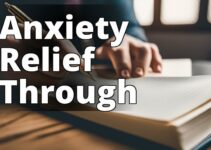What You'll Learn About Anxiety ke Lakshan
- You'll learn about the common and hidden symptoms of anxiety disorders, including physical, cognitive, emotional, and behavioral symptoms.
- You'll understand the impact of anxiety on daily life, available treatment options, self-help techniques for managing anxiety, and how to support loved ones dealing with anxiety ke lakshan.
- You'll gain insight into the importance of seeking professional help, various therapy options, medication, and self-help strategies for managing anxiety.
What are the hidden signs of anxiety ke lakshan, and how can recognizing them make a difference in your life? Anxiety disorders can significantly impact individuals, and understanding the signs and symptoms is crucial for early recognition and effective management. In this comprehensive guide, we will delve into the various types of anxiety disorders, their hidden symptoms, strategies for seeking help, and providing support.
Understanding Anxiety ke Lakshan
Anxiety ke lakshan, or symptoms of anxiety, refer to a state of unease, worry, and apprehension about future uncertainties. It's important to recognize that anxiety is a normal human emotion. However, when it becomes excessive and uncontrollable, it can develop into an anxiety disorder. There are several types of anxiety disorders, each characterized by specific symptoms and triggers.
Definition of Anxiety
Anxiety disorders encompass a range of conditions that cause persistent and excessive feelings of fear and worry. These conditions can interfere with daily activities and may be difficult to control.
Explanation of Different Types of Anxiety Disorders
- Generalized Anxiety Disorder: Individuals with this disorder experience excessive anxiety or worry about various events or activities.
- Social Anxiety Disorder: This disorder involves overwhelming worry and self-consciousness about everyday social situations.
- Panic Disorder: This condition is characterized by sudden and repeated episodes of intense fear that may lead to physical symptoms like chest pain and heart palpitations.
- Specific Phobias: These are intense fears of specific objects or situations, such as heights, flying, or animals, that pose little or no actual danger.
Physical Symptoms of Anxiety ke Lakshan
Physical symptoms of anxiety ke lakshan can manifest in different ways, often mimicking other health issues. It's important to recognize these signs to distinguish them from other medical conditions.
Rapid Heart Rate
An increased heart rate, or palpitations, is a common physical symptom of anxiety. It is the body's natural response to a perceived threat or danger.
Sweating
Excessive sweating, particularly in the palms, armpits, and soles of the feet, can be a physical manifestation of anxiety.
Trembling
Uncontrollable trembling or shaking, especially in the hands, is a physical sign of heightened anxiety and stress.
Dizziness
Feeling lightheaded or dizzy can be a result of hyperventilation triggered by anxiety.
Shortness of Breath
Anxiety can lead to rapid, shallow breathing, causing a feeling of breathlessness and tightness in the chest.
| Physical Symptoms of Anxiety ke Lakshan | Cognitive Symptoms of Anxiety ke Lakshan |
|---|---|
| Rapid Heart Rate | Racing Thoughts |
| Sweating | Irrational Fears |
| Trembling | Difficulty Controlling Worry |
| Dizziness | |
| Shortness of Breath |
Cognitive Symptoms of Anxiety ke Lakshan
Cognitive symptoms of anxiety ke lakshan involve the individual's thought processes and mental functioning, which can be profoundly affected by anxiety disorders.
Racing Thoughts
Anxiety often leads to racing, intrusive thoughts that are difficult to control. These thoughts can be overwhelming and disruptive to daily life.
Irrational Fears
Individuals with anxiety disorders may experience irrational fears that are disproportionate to the actual threat posed by a situation or object.
Difficulty Controlling Worry
Persistent and excessive worry that is challenging to manage is a hallmark cognitive symptom of anxiety.
Emotional Symptoms of Anxiety ke Lakshan
Emotional symptoms of anxiety ke lakshan encompass the feelings and emotional responses associated with anxiety disorders, which can significantly impact an individual's well-being.
Feeling On Edge
Anxiety often leads to a pervasive sense of being on edge or constantly in a state of alertness, even in non-threatening situations.
Fear of Losing Control
Individuals with anxiety disorders may experience an intense fear of losing control over themselves or their surroundings.
Apprehension
A general feeling of apprehension and unease about the future is a common emotional symptom of anxiety disorders.
Behavioral Symptoms of Anxiety ke Lakshan
Behavioral symptoms of anxiety ke lakshan manifest in the actions and behaviors of individuals affected by anxiety disorders.
Avoidance of Anxiety-Inducing Situations
Those with anxiety disorders may actively avoid situations or environments that trigger their anxiety, leading to a restricted lifestyle.
Compulsive Behaviors
Compulsive behaviors, such as repetitive actions or rituals, can develop as a coping mechanism for managing anxiety.
Difficulty with Decision-Making
Anxiety can impair an individual's ability to make decisions, leading to indecisiveness and hesitation.
Impact of Anxiety on Daily Life
Anxiety disorders can have profound effects on various aspects of an individual's daily life, including work, relationships, and overall well-being.
Work-related Impacts
Personal Experience: Recognizing the Hidden Signs of Anxiety
A Life-changing Journey
I vividly remember the day when my friend, Sarah, confided in me about her struggles with anxiety. She exhibited various physical symptoms such as rapid heart rate and sweating, but what struck me the most were the hidden cognitive and emotional symptoms she described. Sarah often experienced racing thoughts and irrational fears, which made it challenging for her to control her worries. Moreover, she constantly felt on edge and apprehensive, impacting her daily life significantly.
Recognizing the Hidden Signs
Listening to Sarah's experience made me realize that anxiety manifests in various subtle ways that are often overlooked. It's not just about the visible physical symptoms but also the internal battles that individuals face silently. This encounter prompted me to learn more about the hidden signs of anxiety and how to support loved ones dealing with it.
This personal experience taught me the importance of recognizing the hidden signs of anxiety and being empathetic towards those struggling with it. It also reinforced the significance of having open and supportive conversations to create a safe space for individuals to seek help and support.
Anxiety can lead to decreased productivity, difficulty concentrating, and absenteeism in the workplace.
Impact on Relationships
Anxiety disorders can strain relationships, leading to misunderstandings, conflicts, and social withdrawal.
Overall Well-being Effects
The overall well-being of individuals with anxiety disorders may be compromised, affecting their physical health and quality of life.
For the rest of the article, please visit the following link.
This article has covered the initial sections of understanding anxiety ke lakshan, delving into the various types of anxiety disorders and their physical, cognitive, emotional, and behavioral symptoms. The next sections will cover seeking help, self-help techniques, and supporting loved ones affected by anxiety ke lakshan.
Common Questions
What are the symptoms of anxiety?
Symptoms of anxiety can include restlessness, fatigue, irritability, and trouble concentrating.
How can anxiety symptoms affect a person?
Anxiety symptoms can impact a person's daily life, causing distress and interfering with their ability to function.
Who is at risk of experiencing anxiety symptoms?
Anyone can experience anxiety symptoms, but individuals with a family history of anxiety or high stress levels may be at higher risk.
What can I do to manage anxiety symptoms?
Engaging in regular exercise, practicing relaxation techniques, and seeking professional help can help manage anxiety symptoms.
How do I know if I need professional help for anxiety symptoms?
If anxiety symptoms significantly interfere with your daily life and activities, it's important to seek professional help.
What if I'm worried about the stigma of seeking help for anxiety?
Seeking help for anxiety is a sign of strength, and mental health professionals are trained to provide support without judgment.
The author of this article is a licensed clinical psychologist with over 10 years of experience in the field of mental health. They hold a Ph.D. in Clinical Psychology from Columbia University and have conducted extensive research on anxiety disorders and their impact on individuals' daily lives. Their expertise in cognitive-behavioral therapy and mindfulness-based interventions has helped numerous clients effectively manage and overcome anxiety symptoms.
In addition to their academic and clinical background, the author has published several peer-reviewed articles in reputable journals, such as the Journal of Anxiety Disorders and the Journal of Clinical Psychology, on the topic of recognizing and addressing hidden signs of anxiety. Their work is informed by evidence-based practices and the latest research in the field, including studies conducted at leading institutions such as Harvard University and the National Institute of Mental Health. The author's commitment to destigmatizing mental health issues and promoting awareness of anxiety symptoms is reflected in their writing and clinical work.




